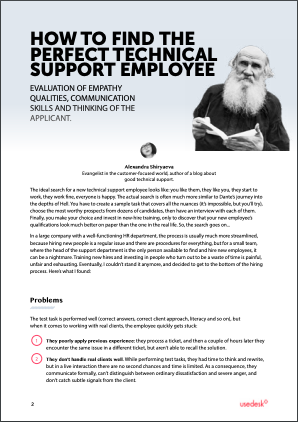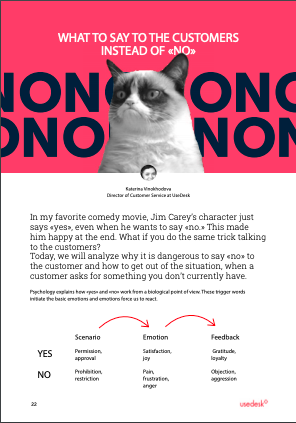Request a Demo
Send us a request for an online demonstration at the time that's convenient for you. We will give you an overview and answer any questions you may have about the system.
By clicking the button, you agree that you have read our Privacy Policy
How to manage customer emotions: step-by-step instructions for IT Support Team
Any tech support person will tell you that the most challenging part is working with high-powered customers. When a person yells or cries into the phone, it becomes pretty difficult to understand the problem, and even impossible — to find a solution. But over the years, we have learned to move from emotion to problem. In the article, we reveal our secrets and give step-by-step instructions for four typical situations.
Katerina Vinokhodova
Usedesk Co-Owner
No empty apologies and regrets
We only apologize if we are really to blame. If the client is dissatisfied with our conditions, we calmly explain why we have it that way. An unnecessary apology is a trigger for the client — it means that we admit that something is wrong with us. But even if we are to blame, stereotyped regrets will only make things worse — you need to apologize competently.
The banal "I'm sorry about the problem" or "I'm sorry for the inconvenience caused" will only make the situation worse. The trouble with the words "problem" and "inconvenience" is in their implications and stereotypes. First can be solved by synonyms that will organically fit into the context; the second — by a complete replacement.
The banal "I'm sorry about the problem" or "I'm sorry for the inconvenience caused" will only make the situation worse. The trouble with the words "problem" and "inconvenience" is in their implications and stereotypes. First can be solved by synonyms that will organically fit into the context; the second — by a complete replacement.
We replace the formulaic apologies that have become hateful to everyone with fresh wording. We choose the words carefully because what is a defect can be the end of the world for the client. We regret not that something went wrong with the client but that we "did not live up to expectations," "failed," "did not keep promises." And after that, we immediately proceed to a constructive solution.
❌ No
✔️ Yes
I apologize for this overlap; we fixed everything.
This is our mistake; please excuse me. Let me help you place your order.
Sorry for ruining the evening. Now let's figure out why you do not have access to movies, and I will help you fix the error.
Sorry, this is our omission! Let's fix it right now.
This is our mistake; please excuse me. Let me help you place your order.
Sorry for ruining the evening. Now let's figure out why you do not have access to movies, and I will help you fix the error.
Sorry, this is our omission! Let's fix it right now.
We are sorry, please accept our apologies.
We apologize for any inconvenience caused.
We apologize on behalf of the company.
I'm sorry, but ...
We apologize for any inconvenience caused.
We apologize on behalf of the company.
I'm sorry, but ...
General scheme of working with an emotional client:
React to emotion
(Something goes wrong!)
(Something goes wrong!)
Give a quickly feedback
(We'll deal with this, this, and that! Let's do this and that.)
(We'll deal with this, this, and that! Let's do this and that.)
Take time out
The first two stages are transformed depending on the mood in which the client came. We will look at four typical options.

A poster with cute emoticons will be favorable to any workplace, plus you will always have a handy cheat sheet at your fingertips.
Worried client
Based on facts and figures, we reassure such a client why there is no need to worry, and we answer in detail each of his questions. In this way, we will gain his confidence and remove all his fears.
It's a bad idea to:
It's a bad idea to:
- apologize, regret, make excuses;
- ignore the client's concerns and questions and respond with formulaic phrases;
- assert that everything is not what the client thinks without backing up his words with facts and figures in reality.

Upset client
For such a client, the main thing is to feel that they have been imbued with his problem; they sympathize with him. To do this, we must give feedback in the process of how the client presents the problem. So he will feel that he is being listened to and he is not alone with his misfortune.
It's a bad idea to:
It's a bad idea to:
- silently listening — this will increase the feeling of resentment and loneliness;
- respond with templates "I'm sorry you ran into this problem";
- dryly report, "we accepted your application."

Passive-aggressive client
This client knows exactly what he wants. He is not up to vocalizing emotions — he is outwardly restrained, focused on the problem, formulates thoughts in a structured and clear manner. It is important to offer him exactly the solution he asked for. We explain in detail what went wrong, why, and what measures we took.
It's a bad idea to:
It's a bad idea to:
- apologize, regret, make excuses, use emotional words;
- accept information without specifying that you and the user understood each other correctly, and think out for him;
- give a general answer, "we accepted your request," without details of how and when you will solve the problem.

Aggressive client
We listen to such a client in silence until he speaks out. Then, ignoring the form of presentation, we calmly react only to the facts related to the problem. We find out the essence of the problem and explain how we will solve it.
It's a bad idea to:
It's a bad idea to:
- respond to aggression, interrupt;
- apologize routinely in the "sorry for the inconvenience" style;
- to warn stereotypically, "if you express yourself incorrectly, I will have to interrupt the dialogue."

Share with your colleagues:
Did you like this article?
Error get alias
We know a lot about customer service
Once every two weeks, we will send exciting and valuable materials about customer service - articles, cases, and system updates. Do you mind?








